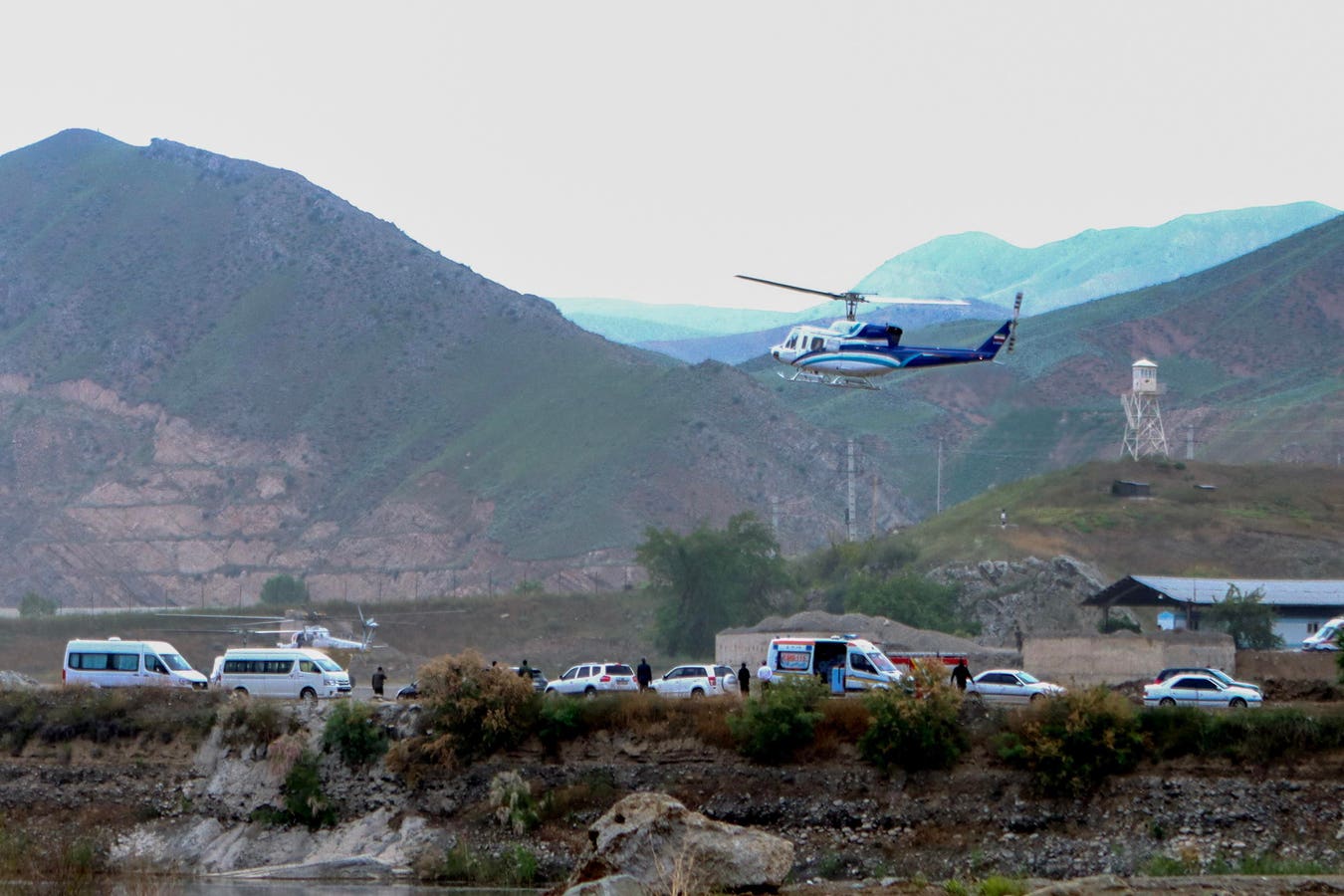While extremely poor weather conditions were likely the leading cause of the helicopter crash that killed Iranian President Ebrahim Raisi and Foreign Minister Hossein Amir-Abdollahian on Sunday, the advanced age of the helicopter is something that cannot be simply overlooked.
The crash of the American-made Bell 212 also killed the governor-general of Iran’s East Azerbaijan Province and the Friday prayer leader of Tabriz, East Azerbaijan’s provincial capital. The president was returning from a trip where he met the president of neighboring Azerbaijan to inaugurate a new dam. Why the helicopter was authorized to fly in foggy weather and extremely low visibility in a mountainous region is unclear.
What is clear is the Bell 212, while undoubtedly a durable and venerable helicopter carrying the president and these officials, was most likely 40-50 years old and acquired by Iran under the last shah preceding the 1979 revolution, when Washington and Tehran had warm ties.
(Incidentally, in the 1970s, the last shah had ceased driving around Tehran after two assassination attempts, opting instead to fly over the city via helicopter for security reasons and, thus, unwittingly increasing his isolation from the Iranian population.)
The potentially problematic age of the helicopters ferrying around the Iranian president on his frequent trips across the country was raised in a leaked classified 2023 letter to First Vice President Mohammad Mokhber. (Mokhber will now serve as a caretaker president until the holding of a new presidential election within 50 days.) The letter emphasized Iran’s requirement for two Mi-17A2 helicopters from Russia for a purported cost of $32 million, highlighting the “high frequency” of Raisi’s helicopter flights.
Javad Zarif, the late Amir-Abdollahian’s predecessor as foreign minister, unsurprisingly sought to pin some of the blame on the United States, lamenting that American sanctions “bar Iran from procuring essential aviation parts.”
What Zarif, as his wont, predictably failed to mention is the repeated occasions in which Iran has commandeered its civilian airliners to transport weaponry to Russia for use against Ukraine and its proxies in numerous war-torn Middle Eastern countries.
Under the shah, America supplied Iran with hundreds of modern helicopters, including 205 AH-J International attack helicopters and CH-47C Chinook utility helicopters. But with the fleet’s 1970s heyday long in the rearview mirror, Tehran cannot heavily rely on its American-built helicopters for much longer.
The 2023 letter to Mokhber concerning the Mi-17 utility wasn’t surprising. Acquiring more Mi-17s from Moscow could enable Iran to retire its older Bell helicopters. Iran’s largest helicopter acquisition since 1979 was a fleet of approximately 40 Mi-8 and Mi-17 helicopters from Russia in the early 2000s.
Since Russia invaded Ukraine, it has become less reliable in supplying spare parts and technical support to its clients in a timely fashion. Neighboring Iraq, which heavily relied on Mi-17 to support its soldiers fighting Islamic State remnants in rural and mountainous parts of the country, is suffering issues maintaining its Russian helicopters. Consequently, Baghdad is buying Bell helicopters from Washington to replace them.
Iran is acquiring Mi-28 attack helicopters from Russia alongside its order of an estimated two dozen Su-35 Flanker jets.
Despite signing a 25-year strategic agreement with Iran in 2021, China hasn’t supplied significant military hardware to Tehran since the 1980s, during the bloody Iran-Iraq War that raged throughout that decade. Beijing has also reportedly proven reluctant to help Iran upgrade its air force by providing J-10C multirole fighter jets.
The American F-14A Tomcat remains the apple of the Iranian Air Force’s eye to this day, just under a half-century since Tehran began receiving them from the United States in 1976. However, Iran’s vintage American-built fighter fleet, along with some of the Russian jets it acquired from the Soviet Union in and around 1990, have seen repeated technical failures and crashes, largely due to their age, in recent years.
Ironically, one country that previously helped Iran improve its domestic aviation sector by co-developing an Iranian version of the Antonov An-140 turboprop airliner was Ukraine. Iranian-Ukrainian relations completely ruptured after Iran shot down a Ukrainian civilian airliner over Tehran in January 2020 and then supported Moscow’s 2022 invasion by supplying thousands of drones Russia has repeatedly used against Ukrainian cities.
Another revealing occurrence during the search for Raisi’s crashed Bell 212, which took hours given the poor visibility and rugged terrain, was Iran accepting Turkey’s offer to dispatch an advanced Bayraktar Akinci drone to help the search and rescue efforts. The Turkish Akinci is outfitted with advanced sensors and thermal technology and was therefore ideally suited for finding the missing helicopter, which, according to Turkey’s transportation minister, either had its transponder off or lacked one altogether.
The Akinci’s leading role in the search is embarrassing for Iran for two reasons. Firstly, the province where Raisi’s helicopter went down is home to the 2nd Tactical Air Base, 10 miles northwest of Tabriz, which houses light search and rescue aircraft. (Furthermore, the Akinci overflew several sensitive military sites inside Iran during its mission, including a rapid response base.) Secondly, Iran has boasted in recent years of the popularity of its drones.
In 2022, Raisi bragged that numerous heads of state had told him, “Your industry is more advanced. It is different from the rest of the world.”
Despite such claims, Iran’s drone industry cannot hope to replicate the export success of neighboring Turkey, at least under the present regime. And the fact it was a Turkish drone that played a prominent role in Sunday night’s search as opposed to an indigenous Iranian one was conspicuous.
Raisi’s sudden and unexpected death is a striking reminder of how unpopular politics and unbelievable incompetence—by flying in such poor weather conditions in the first place while potentially lacking a transponder—has all but doomed Iran’s military and utility aircraft fleet, once among the best anywhere in the world.
Read the full article here





